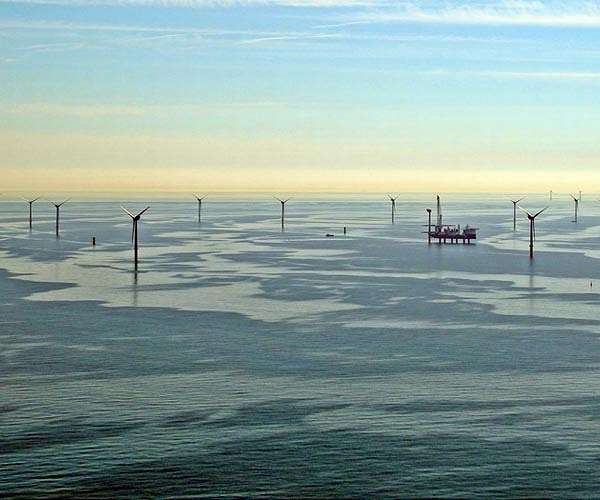
By Anthony Allard, Head of North America, Hitachi Energy
The debate around the progress of the clean energy transition has often centered on generation, specifically, whether we can produce enough wind and solar power to displace fossil fuels. This is a valid concern, but equally critical is the need to make sure that we have the ‘plumbing’ in place to get this clean power from where it is generated to where it is needed. Here in the U.S., this challenge is particularly acute. When I say plumbing, I’m referring to transmission and distribution networks.
In the case of wind power, the energy generated by the turbines offshore needs to be transported back to shore – often over very long distances – and integrated with existing grids. However, given the scale of development taking place in the U.S., particularly on the east coast, it is unlikely that local markets will be able to absorb all the power being generated in local waters. For instance, current plans call for approximately 6 GW of capacity to be developed off Long Island, which would turn this region into a net exporter of power for the first time.
Similar dynamics exist in other parts of the country, such as the Midwest and desert Southwest. Both areas are attractive for renewable energy developers, but the best sites for development are often located far from established transmission corridors or major load centers. Transporting the power from these locations to other markets will require a more robust transmission grid serving a broader, diverse mix of geographies.
This mismatch between the areas served by existing transmission resources and the locations most attractive for renewable generation is one of the biggest bottlenecks slowing the progress of the clean energy transition. Addressing this bottleneck is a critical requirement for the United States and for North America more broadly if we are to achieve our collective carbon reduction targets and slow climate change.
Policy Challenges
Unfortunately, a variety of structural impediments make this goal difficult to accomplish. First, transmission systems frequently need to cover long distances and often cross state (and occasionally national) borders. This can make for arduous siting and permitting and processes, which can be extremely complex and contentious. As a result, political dynamics, public sentiment, and regulatory requirements can be the deciding factors in the success or failure of a given project.
Due in part to this fragmented process, the U.S. lacks a nationwide grid or sufficient transfer capacity between the existing regional interconnections to move large amounts of power between regions. There is currently no overarching national plan for electricity transmission in the U.S. Establishing such a plan would be an important step toward reducing the transmission bottleneck. It would aid in assessing a variety of requirements, including:
- The best potential locations for renewable energy development
- Locations of existing transmission lines and gaps
- Areas requiring more capacity
- Opportunities to strengthen transfer capacity between different regional grids and the interconnection areas
If such a plan is developed and implemented, it could facilitate the more effective sharing of power between different regions. This would offer a variety of benefits, such as helping to address localized supply shortages resulting from extreme weather events. It would also provide the capability to address the time-of-day challenges associated with renewable energy sources, which are not dispatchable.
For instance, during daylight hours, when solar generation in California is at its peak, excess power could be shipped back east to serve load centers in the center of the country. Similarly, in the evening, when wind power is abundant in the Midwest, available power could be shipped to the West Coast to fill the gap created as solar resources go offline. This kind of sharing is not possible today at anything like the scale needed to support the clean energy transition.
A siting and permitting process where national interest would prevail over local interests would be an ideal way to achieve high-level objectives, but political realities make this approach challenging. An alternative that could be explored is a collaboration between neighboring states to establish regional plans. This could help smooth the way for projects that have the potential to support the development of systems to support the regional sharing of power.
Technology solutions
The primary obstacles to the achievement of this goal are not technical. The key technologies needed to expand the transmission grid and resolve some of our most critical interconnection challenges are mature and available today. Advanced transmission technologies, such as high-voltage direct current (HVDC) and power quality solutions, such as flexible alternating current transmission systems (FACTS) have already proven themselves effective at meeting the transmission needs of utility-scale renewable energy projects and high-capacity regional interconnections. Such systems are already in commercial operation, addressing exactly these kinds of challenges around the world, most notably in Europe.
There is no reason we shouldn’t be putting the same kinds of systems in place in North America. Fortunately, there is growing interest and activity in the U.S. and Canada around the establishment of large-scale, long-distance electrical transmission systems, particularly to link renewable energy generation sources with load centers. And we have begun to see some positive movement in terms of concrete commitments.

Hitachi Energy announced the successful commissioning of a 500 kV – 1400 MVAr series capacitor bank, one of the largest in the world, on March 31, 2021 for Minnesota Power’s?Great Northern Transmission Line project.
FACTS solutions offer a means to upgrade existing AC transmission grids to take advantage of systems that have already been permitted. A recent project Hitachi Energy completed with Minnesota Power addressed exactly this kind of opportunity.
Similarly, Hitachi Energy recently announced its involvement in a major renewable electricity transmission project called Champlain Hudson Power Express (CHPE), an HVDC interconnection between Quebec, Canada and the New York City metro area. CHPE will transfer up to 1,250 megawatts of electricity, enough to power 1 million New York households, which also helps to address the State of New York’s carbon reduction goals.
If we want to see a real impact in transitioning from fossil fuels to renewable energy sources, we need to see many more projects like CHPE and Minnesota Power. The demand for electricity is increasing, and this trend will accelerate as we electrify more sectors of the economy, like transportation, manufacturing, mining and more.
By reaching a collective agreement on the scope and broad outlines of the transmission needs in North America and removing or mitigating the structural impediments that are delaying or preventing the development of needed transmission projects, we could lay the foundation for the successful pursuit of our collective efforts to minimize the impacts of climate change. The U.S. government, local governments and industry have an opportunity to work together to accelerate the expansion of much-needed transmission resources. The sooner we get started, the better.
Learn more on Hitachi Energy’s website
Sponsored content by Hitachi Energy
Filed Under: Sponsored Content






